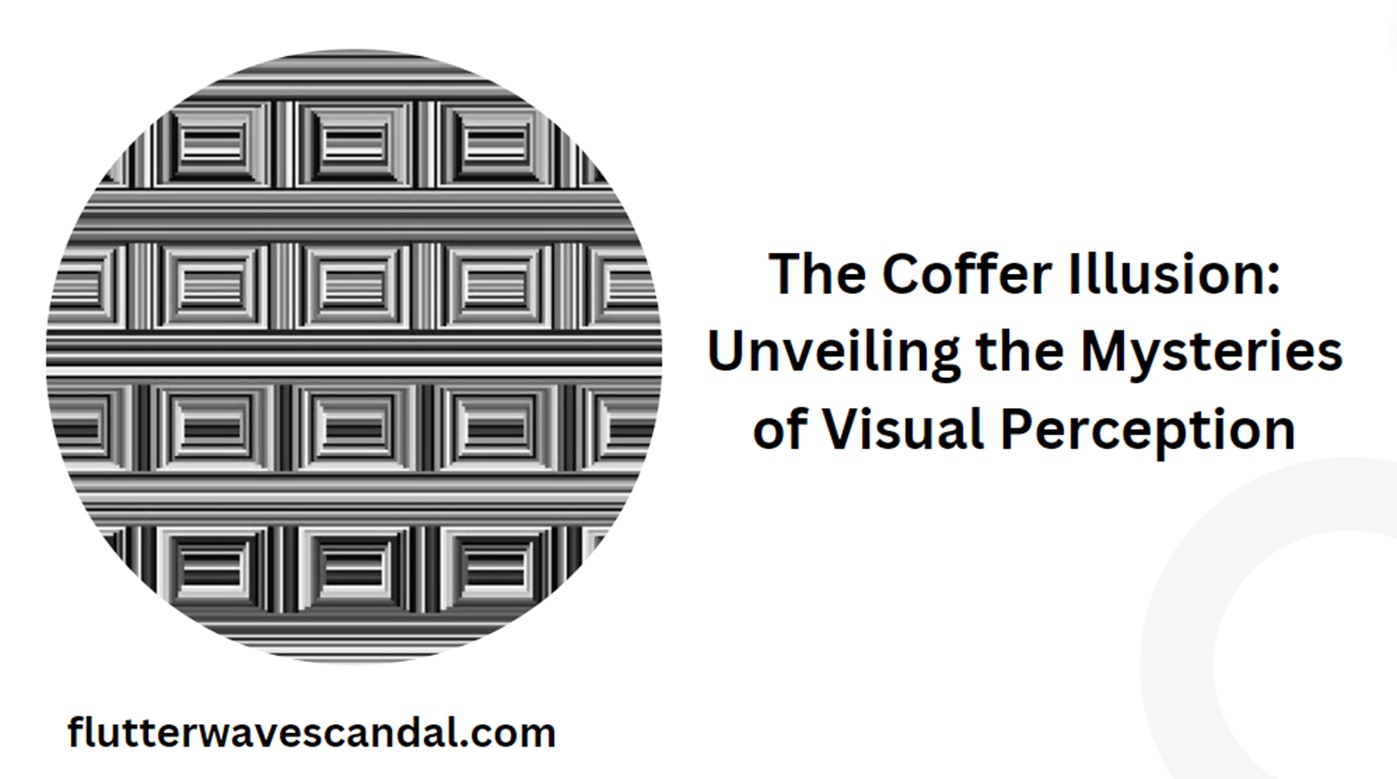
The coffer illusion is a fascinating and captivating example of how our brain interprets visual information. This illusion plays with our perception, making us see different shapes within a complex pattern. In this article, we will delve into the coffer illusion’s history, mechanics, psychological implications, and its significance in understanding human perception. We’ll also explore related illusions and how they help unravel the intricacies of our visual system.
Table of Contents
Introduction to the Coffer Illusion
The coffer illusion is a visual phenomenon that tricks our brain into seeing different shapes within a pattern of intersecting lines. Typically, people first perceive a series of rectangular “coffers” or panels, but with a shift in focus, hidden circles emerge within the pattern. This illusion demonstrates the brain’s remarkable ability to interpret ambiguous visual stimuli based on context and previous experiences.
What is the Coffer Illusion?
The coffer illusion is created by arranging lines in a grid-like pattern where the intersection of these lines forms rectangular shapes. However, within this grid, there are hidden circles that are not immediately apparent. Most viewers initially see only the rectangles, but with careful observation, the circles become visible. The illusion challenges our perception and highlights how our brain processes visual information.
Historical Background
The coffer illusion, like many visual illusions, has roots in the study of human perception and cognitive psychology. While the specific origins of the coffer illusion are not well-documented, it draws on principles of Gestalt psychology, which emerged in the early 20th century. Gestalt psychologists studied how the human mind perceives patterns and organizes visual information into meaningful wholes.
Mechanisms Behind the Coffer Illusion
Understanding the coffer illusion involves exploring how our visual system processes and interprets complex patterns. Several factors contribute to the illusion’s effectiveness, including perceptual grouping, context, and cognitive biases.
Perceptual Grouping
Perceptual grouping is a fundamental principle of Gestalt psychology. It refers to the brain’s ability to organize visual elements into coherent groups based on similarities, proximity, and continuity. In the coffer illusion, the intersecting lines are initially grouped into rectangular shapes, creating the perception of “coffers.” This grouping occurs automatically and influences our initial interpretation of the pattern.
Context and Previous Experiences
Context plays a crucial role in how we perceive the coffer illusion. Our brain relies on previous experiences and expectations to interpret visual information. When confronted with the coffer illusion, our brain draws on its familiarity with rectangular shapes, leading to the initial perception of coffers. The hidden circles challenge this interpretation, requiring a shift in focus and cognitive effort to see the alternative pattern.
Cognitive Biases
Cognitive biases, such as the tendency to favor familiar patterns, also contribute to the coffer illusion. The brain’s preference for familiar shapes, like rectangles, makes it more likely to interpret the intersecting lines as a grid of coffers. Recognizing the hidden circles requires overcoming these biases and adopting a different perspective.
Psychological Implications of the Coffer Illusion
The coffer illusion offers valuable insights into human perception and cognitive processes. By studying how people perceive and interpret the illusion, researchers gain a deeper understanding of the brain’s mechanisms for processing visual information.
Perceptual Set and Selective Attention
The coffer illusion demonstrates the concept of perceptual set, which refers to the brain’s predisposition to perceive certain aspects of a stimulus based on context and expectations. When viewing the coffer illusion, our perceptual set initially favors the rectangular shapes. Shifting attention to the hidden circles requires overcoming this perceptual bias and selectively focusing on different elements of the pattern.
Cognitive Flexibility
Recognizing the hidden circles in the coffer illusion requires cognitive flexibility—the ability to shift between different interpretations of visual stimuli. This flexibility is essential for adapting to new information and solving problems. The coffer illusion serves as a reminder of the brain’s capacity for cognitive flexibility and its importance in everyday perception and decision-making.
Visual Learning and Expertise
Studies have shown that expertise and visual training can influence how people perceive the coffer illusion. Individuals with experience in visual arts, design, or related fields may be more adept at recognizing the hidden circles due to their trained ability to analyze complex patterns. This highlights the role of learning and expertise in shaping our perceptual abilities.
The Coffer Illusion in Art and Design
The coffer illusion’s intriguing interplay of shapes has inspired artists and designers to explore its potential in various creative fields. By incorporating the illusion into their work, they challenge viewers’ perceptions and create visually engaging experiences.
Optical Art and Illusions
Optical art, or Op Art, is a genre that emphasizes visual illusions and perceptual effects. Artists like Bridget Riley and Victor Vasarely have used patterns similar to the coffer illusion to create dynamic and immersive artworks. These pieces often feature repeating geometric shapes and contrasting colors, resulting in optical illusions that captivate and disorient viewers.
Architectural Applications
Architects have also drawn inspiration from the coffer illusion to design buildings and spaces that play with perception. By integrating patterns of intersecting lines and hidden shapes into architectural elements, they create environments that challenge traditional notions of space and form. These designs encourage viewers to engage with the built environment in new and thought-provoking ways.
Graphic Design and Advertising
Graphic designers and advertisers use the principles of the coffer illusion to create visually striking and memorable designs. By incorporating hidden shapes and patterns, they capture viewers’ attention and encourage them to spend more time exploring the visual content. This approach enhances the effectiveness of advertisements and branding materials.
Related Visual Illusions
The coffer illusion is part of a broader category of visual illusions that exploit the brain’s perceptual processes. Understanding related illusions provides a comprehensive view of how our visual system operates and how it can be deceived.
The Kanizsa Triangle
The Kanizsa triangle is an illusion where the brain perceives a complete triangle even though only three Pac-Man-like shapes and three angles are present. This illusion demonstrates the brain’s tendency to create coherent shapes from incomplete information, similar to how it interprets the coffer illusion.
The Rubin Vase
The Rubin vase is a classic example of a figure-ground illusion. Viewers can see either a vase in the center or two faces in profile on the sides, but not both simultaneously. This illusion highlights the brain’s ability to switch between different interpretations of ambiguous stimuli, akin to the shift required to see the hidden circles in the coffer illu sion.
The Necker Cube
The Necker cube is an illusion where a two-dimensional drawing of a cube can be perceived from different perspectives. The brain alternates between these perspectives, demonstrating its ability to process multiple interpretations of a single image. This phenomenon is similar to the cognitive flexibility needed to recognize the hidden circles in the coffer illusion.
The Neuroscience of Visual Illusions
Advances in neuroscience have provided insights into the brain mechanisms underlying visual illusions, including the coffer illusion. By studying neural activity and brain regions involved in perception, researchers gain a deeper understanding of how illusions work.
Visual Processing Pathways
The brain’s visual processing involves multiple pathways that analyze different aspects of visual information. The dorsal pathway processes spatial information and motion, while the ventral pathway is responsible for object recognition and form. The coffer illusion engages both pathways, as the brain must interpret spatial relationships (rectangles) and recognize hidden shapes (circles).
Role of the Visual Cortex
The visual cortex, located in the occipital lobe, is crucial for processing visual information. It contains specialized areas that respond to different visual features, such as edges, shapes, and colors. The coffer illusion activates these areas as the brain analyzes the intersecting lines and searches for hidden shapes.
Neural Adaptation and Plasticity
Neural adaptation and plasticity are essential for understanding how the brain perceives illusions. When exposed to an illusion, neurons in the visual cortex can adapt their responses, leading to changes in perception. This adaptability allows the brain to switch between different interpretations of the coffer illusion and recognize hidden shapes.
Practical Applications of Visual Illusions
Beyond their artistic and psychological significance, visual illusions like the coffer illusion have practical applications in various fields. These applications leverage the principles of perception to enhance user experiences and improve functionality.
Human-Computer Interaction
In human-computer interaction (HCI), visual illusions can be used to create intuitive and engaging user interfaces. By incorporating perceptual tricks, designers can guide users’ attention and improve the usability of software and digital devices. The coffer illusion’s principles can inform the design of interfaces that effectively communicate complex information.
Cognitive Rehabilitation
Visual illusions have potential therapeutic applications in cognitive rehabilitation. For individuals with perceptual or cognitive impairments, engaging with illusions can stimulate neural activity and promote recovery. The coffer illusion, with its emphasis on cognitive flexibility and visual processing, can be used as a tool in rehabilitation programs.
Education and Training
Educators can use visual illusions to teach concepts related to perception, psychology, and neuroscience. The coffer illusion provides a tangible example of how the brain processes visual information, making abstract concepts more accessible to students. Additionally, training programs for visual professions, such as art and design, can incorporate illusions to enhance perceptual skills.
Conclusion
The coffer illusion captivates and intrigues us by challenging our perceptions and revealing the complexities of visual processing. By exploring the mechanisms behind the illusion, its psychological implications, and its applications in various fields, we gain a deeper appreciation for the brain’s remarkable abilities. The coffer illusion serves as a reminder of the intricate interplay between perception, cognition, and reality, inspiring ongoing research and creativity in understanding human vision.




